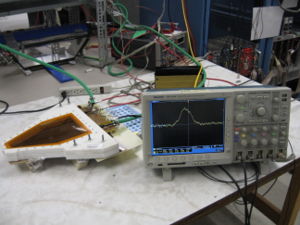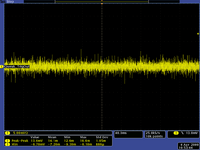Difference between revisions of "Ionization Chamber"
| Line 18: | Line 18: | ||
[[Image:QweakTrigOut_Scope_and_Detector_3-04-09_1.jpg|300px]] | [[Image:QweakTrigOut_Scope_and_Detector_3-04-09_1.jpg|300px]] | ||
| − | As shown below, the noise level has a peak to peak amplitude of about <math>(14 \pm 1 )</math> mV. The "TrigOut" pulse is almost a factor of | + | As shown below, the noise level has a peak to peak amplitude of about <math>(14 \pm 1 )</math> mV. The "TrigOut" pulse is almost a factor of (SNR=) 1.5 higher than the noise. The VFAT amplifier cards will be located on the strips improving the SNR. |
[[Image:QweakNoiseLevel_2_3400V_3-04-09.png|200px]] | [[Image:QweakNoiseLevel_2_3400V_3-04-09.png|200px]] | ||
Revision as of 03:32, 12 April 2009
Qweak Chamber machining
Qweak_Chamber_Assembly
The scope picture(100ns/div and 5 mv/div) below shows the Qweak GEM chamber's "TrigOut" pulse caused by a cosmic ionization event in the Qweak R1 detector. The "TrigOut" pulse is about 20 mV in height and 50 ns wide. The pulse represents electrons leaving the last GEM preamplifier stage and is therefore a positive going pulse. The high voltage was set to -3400 Volts on the cathode and -3100 Volts on the GEM foil voltage divider network which powers all three GEM foil preamplifier stages. The chamber was filled with a gas mixture composed of 90% Argon and 10% CO2 by volume.
As shown below, the noise level has a peak to peak amplitude of about mV. The "TrigOut" pulse is almost a factor of (SNR=) 1.5 higher than the noise. The VFAT amplifier cards will be located on the strips improving the SNR.

